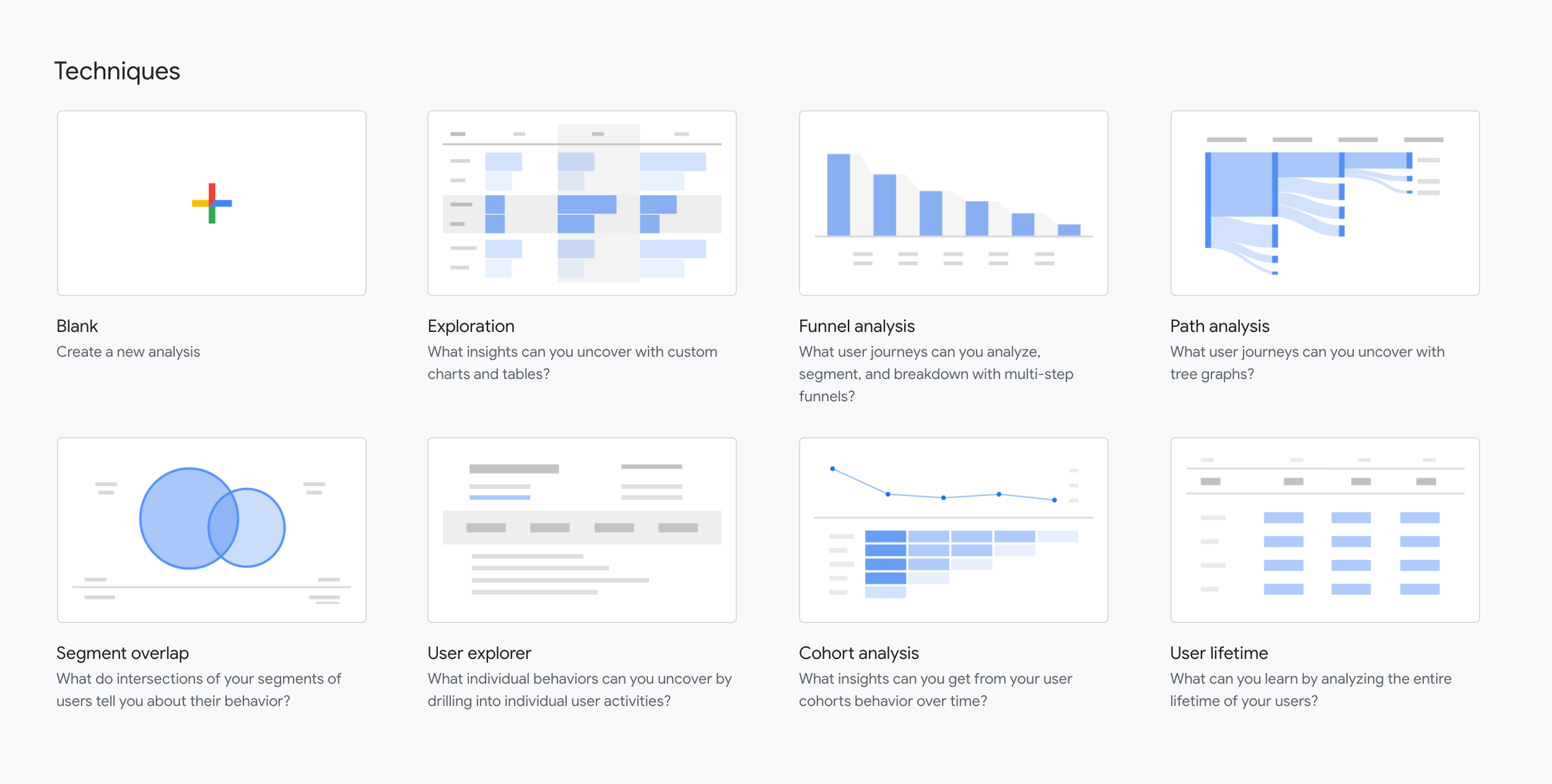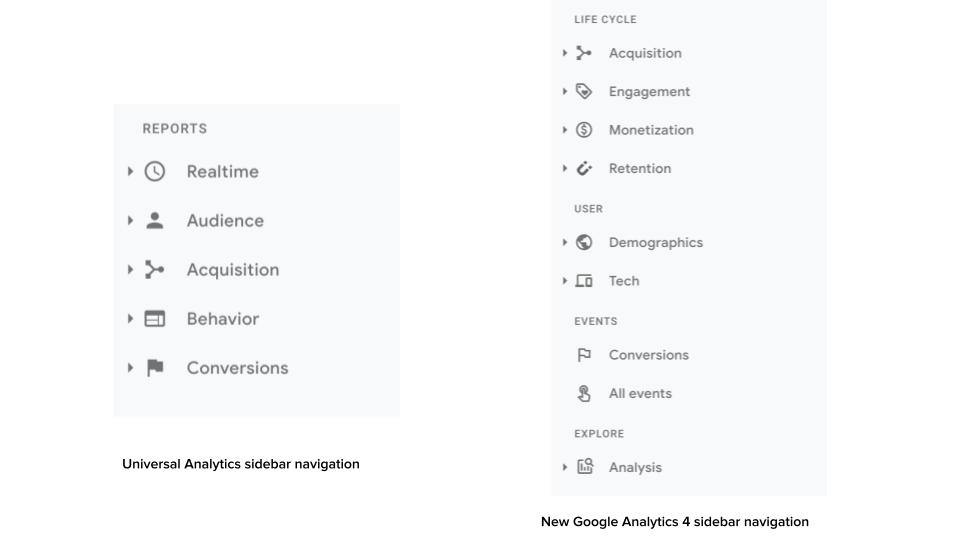
What is Google Analytics 4?
Need help with your GA4 instance?
Table of contents
- What is Google Analytics 4?
- Why is Google Analytics 4 (GA4) replacing Universal Analytics?
- Why should I use GA4?
- What’s Changing in GA4 vs Universal Analytics?
- Recommended next steps
- GA4’s Frequently Asked Questions (FAQ)
What is Google Analytics 4?
Simply put, Google Analytics 4, or GA4, is the latest update to Google’s free analytics software. Google has made many updates to their widely used web and app analytics tool over the years.
Google bought Urchin Software in 2005. Urchin’s web tracking software is the foundation of all the Google Analytics versions you’ve interacted with to date.
In fact, you know the “UTM” tag? It stands for URCHIN Tracking Module.
By mid-2006, The Google-branded web tracking tool was available to any and everyone. The rest is history.
Now, Google has released Google Analytics 4 (previously known as App + Web).
App+Web was developed on top of Google’s Firebase which is another product Google purchased, this time in 2014 as mobile was really gaining steam.
Why is Google Analytics 4 (GA4) replacing Universal Analytics?
We believe Google is releasing GA4 for many reasons, many of which tie back to this idea of a “modern measurement solution.”
We believe the underlying technology is likely much more modern and thus scalable and maintainable. Recall that all the previous versions of Google Analytics have been built on Urchin’s code base, which dates back to pre-2005. Now, GA4 could see faster future development thanks to an updated codebase.
Why GA4 is a “modern measurement solution”
If you have a mobile app and a website, you had two different data sets until July 2019 when Google gave you App + Web. This is the 2nd reason for GA4: to provide one set of data to help you draw insights about your user experience.
Nowadays, every business (and website/app) has things that make it unique. GA4 is much more flexible than any previous Google Analytics version.
Sure, you had the ability to push custom metrics and dimensions into Universal Analytics, giving some flexibility to capture what’s unique to your business. However, with GA4, everything is driven by “events” which carry parameters (more on that later).
Think “key-value pairs”. You get to define what those key-value pairs are, leading to endless possibilities and allow you to configure the tracking and measurement to specifically to your business.
Consider event tracking in Universal Analytics. You had three levels to put your data: category, action, and label. With GA4, you’re no longer limited or constrained by these pre-built nomenclatures. That’s a good and bad thing though, as you’ll need to consider how to configure your events such that you can later report and analyze them.
Google also touts GA4 to be “privacy-centric by design”. This is important to meet user expectations, (potential future) regulatory changes, and developments in technology standards. The “wild wild west” that is the internet is slowly but surely becoming more standardized and regulated – and Google wants their Analytics product to thrive in that future.
All these reasons make us believe that Google is intending to move “upstream”. They’re providing a true “Analytics Platform” that’s flexible enough to compete with the likes of Adobe. At the same time, they’re creating a tighter integration with their other products — so you stick with them.
Why should I use GA4?
First off, because you kind of have to. If you’re using the current version of Google Analytics (Universal Analytics), your reports will stop processing new data on July 1, 2023.
So it’s a good idea to start using GA4 as soon as possible. You’ll start collecting data for period-over-period analysis as well as get used to using the new reports and features.
What are these “new reports and features”, you ask?
We’ve picked out a handful we think you’ll like:
Predictive insights through machine learning
Google is always improving their machine learning and GA4 is structured to bring even more analytics insights your way. It can predict churn, show you anomalies, and create audiences of your best customers (so you can use them in advertising campaigns or otherwise understand their journey).
Note: You’ll need to set up your GA4 event tracking in an organized fashion, using some of Google’s standard events (more on that later). We can help with our GA4 services.
Retroactive funnel reporting
We love funnels. They’re the best way to track the key steps you want a user to take on their path to converting. In GA4, you can use the “Funnel Exploration” report to create a funnel on the fly.
This was never possible with any previous version of Analytics.
Before, in Universal Analytics, if you wanted to capture the funnel steps for a particular goal, you’d have to set up the pageviews of that funnel – and only data collected after the setup was complete would be considered. If you had data for the funnel before it was configured, it was omitted. This is the same with eCommerce checkout behavior reports.
Very expandable and flexible
GA4 uses an “events with key/value pairs” data model. This modern framework allows for a lot of flexibility.
Three major use cases include:
- Customizing event names to map to specific behaviors you want your users to take, so you can use that funnel or path analysis we talked about earlier.
- Capturing form submission data on a “generate_lead” event. Careful, don’t capture any PII (personally identifiable information) as that’s against Google’s terms. But you could capture some non-PII indicators of lead quality and use that for analysis.
- Mapping some key touchpoints or data parameters that are found in your CRM to GA4 and bringing that data in to use in segmentation, audience building, or analysis otherwise.
Attribution settings
Attribution is one of the most challenging topics to master in marketing. Even with the advent of digital marketing/advertising, it’s still murky.
In GA4, you can adjust the attribution model that’s used across ALL of your reports. While Universal Analytics had a “attribution model comparison” report, it wasn’t very powerful and certainly didn’t allow you to shift your attribution model across all your reports.
GA4 does have a model comparison report as well. The default attribution model is set to “cross-channel data-driven model” as well. This uses an algorithm to analyze paths that converted vs. those who didn’t to come up with a model which gives [partial] credit to the channels that influence your conversions.
When trained well, this data can be illuminating when marketers want to answer “what’s working, what’s not?”
Data deletion requests
Have you ever seen a spike in your data that you knew was a fluke? Maybe you forgot to block your office IP address? Or you included your GA code in your staging environment? Or, maybe, a bunch of bots spammed your site?
Or, even worse… someone put YOUR analytics code on their website – leading to junk data in your analytics instance? OR, maybe the worst case… you accidentally captured PII in your event labels or URL query strings?
We’ve seen it all.
Luckily, in GA4, you can request for data to be deleted. Just choose the event names, or filter by parameter keys or values. Voila, clean data.
Bonus: GA4 allows for Server Side GTM (SSGTM) – which can eliminate the case of malicious or accidental fake data getting into your analytics database.
Enhanced measurement, out of the box
We used to configure Universal Analytics to track things like scroll depth, outbound link clicks, file downloads, search results, video engagement, and more. Now, with GA4’s enhanced measurement, you can click a button and have all that tracked for you. Thanks, Google.
What’s Changing in GA4 vs Universal Analytics?
A lot. GA4 is now an Analytics Application/Platform. This might sound obvious, but the majority of people have been using Universal Analytics solely as a reporting tool.
We go in-depth on several key differences between Google Analytics 4 vs. Universal Analytics here. That said, here are a few highlights:
GA4 reporting is WAY different
Bad news: Most of the “canned reports” are gone.
While there are some canned (out-of-the-box) reports, they just aren’t what you’re used to — or what you might want. The canned reports are high level overviews.
Here’s a rough mapping of the Universal Analytics standard reports vs GA4’s standard reports:
- Audience is now… gone? Well, parts of it are found in different places, mainly the Demographics and Tech reports under the User section.
- Acquisition remains!
- Behavior is now Engagement.
- Conversions exist, but under the Events section.
- There are two new reports as well:
- Monetization handles the eCommerce reports
- Retention deals with returning users and cohorts

The good news is that you can customize your left sidebar navigation to house only the reports you need or use the most often. To do that, click “Reports” on the left-most sidebar, then “Library” at the bottom of the Reports sub menu (on the left, but to the right of the Reports link you first click).
Google now wants you to use their new Explore tool to, well, explore and analyze data. This is very powerful stuff. We’ll do a whole post on the analysis techniques available in GA4.
GA4 setup and data piping
Google wants you to use Google Tag Manager to configure the collection of data that you’ll later want to analyze. Google Analytics acts as the data processor and engine for analysis. Then, for reports you want to view on regular cadence, you’ll use GA4 data piped into Google’s Data Studio.
Have a lot of data and/or want to use a different BI tool? Good news: You can connect a BigQuery database directly to your GA4 instance and all the data will be made available there, from which you can connect your favorite BI tool.
GA4 events: Some standards, lots of flexibility
In GA4, everything is an event. That’s the root of the new data model.
If you know some of the measurement protocol — eg. users have many sessions and sessions have many hits — then you’re in decent shape. But there are some changes.
Sessions, hits, scopes, products, etc.. — most of the vernacular you’re used to is gone.
Hits are now events. Makes sense. Event means something happened. A pageview, button click, scroll, add to cart, conversion… all events.
You’ll also see mobile app terminology mixed in. Specifically the term “screen name” or “screen class” — which is akin to “page title” for the web.
Goals are now “Conversions”. You can specify which events are considered conversions.
This might seem confusing, but it does unlock some power and flexibility.
For one, you can log and create events with up to 25 custom event parameters per event. Just be careful, there are limits. Don’t go dynamically creating event names because you can’t delete them once they’re in there.
Now, there are standard events and parameters captured with every event.
There are even some “predetermined” events that Google recommends using. Here are some examples we’ve added to our internal SOP.
B2B
- generate_lead
- sign_up
- select_content
- add_to_cart
- begin_checkout
- add_shipping_info
- add_payment_info
- purchase
SaaS
- login
- Sign_up
We DO recommend using these where possible as we think it’ll be key in training the machine learning algorithm to later deliver you predictive analysis or insights.
Lastly on the flexibility front, with the click of a couple buttons, you can ship your raw GA data into a Google BigQuery database. Perfect for retaining data beyond the 14 month maximum (at the time of this writing this is set by default to 2 months and you need to change it to 14 months) and combining with “offline” data (e.g. from CRM).
UTM tags are NOT changing!
We tested UTM query parameters (eg. utm_source) and they work! The data gets captured in the event parameters of source, medium, campaign, and so on.
This makes sense as 100% of the world’s digital marketers have adopted UTM tagging (don’t fact check that) — long live Urchin!
Recommended next steps
Well, it’s your choice… you can do one or more of the following:
- Do nothing.
- Continue learning and stay up to date with GA4.
- Install a GA4 instance in parallel with your current Analytics installation.
We recommend #2 and #3.
Google Analytics 4 is still in early stages, with new features being added on a daily/weekly basis. We are experimenting by installing and configuring it, but we aren’t completely switching to GA4 in the next quarter. The main reason for that is the lack of historical data. Until there’s an easy way to port historical data from Universal Analytics to GA4, we’ll just collect data in parallel.
We are creating an SOP. Similar to when Universal Analytics came out, we’ve designed and documented a standard operating procedure for configuration guidelines, naming conventions, and other best practices to ensure we’re fully utilizing the platform.
Alongside the Analytics SOP, we maintain a Google Tag Manager boilerplate which standardizes nomenclature and helps us deploy measurement quickly.
Reach out if you need help with your Analytics.
GA4 FAQs
What’s WebMechanix doing with GA4?
We’re experimenting with the installation, configuration, integration, and analysis engine of GA4. We’ll soon be running GA4 in parallel with UA on a handful of select clients. Ultimately, we’ll have a SOP (standard operating procedure) for GA4 that’ll optimize the deployment and effectiveness of the platform.
What’s going to happen with Universal Analytics (UA)?
It’s going away. Google has already stopped updating it. On July 1, 2023, no more data will be processed into Universal Analytics.
Can we import our UA data into GA4?
There isn’t a “point and click” way to import your current analytics data into GA4. But, GA4 does have a data import feature, so there is a way to get it out of UA and into GA4. Our current recommendation is to run a GA4 property in parallel to your Universal Analytics.
What does this mean for my business?
Google has some powerful algorithms and cloud computing that they’ve effectively made free to anyone who has a website. The problem is, to effectively use these tools, it requires configuration and integration with other business applications (eg. CRM, Marketing Automation, CDP, ERP, etc..).
Consider talking to your CMO and/or the person responsible for your enterprise data/analytics to see if GA4 is right for you. We’re happy to help as well.
What if I want to tinker with GA4 on my website(s)?
Install it in parallel with your existing UA property where you can investigate the new software yourself.
Why should we spend the time/money on migrating to GA4?
Well, if you rely on UA (Universal Analytics) for any type of critical marketing reports, you really don’t have a choice (unless you migrate to a different tool entirely). UA will no longer process new data in standard properties beginning July 1, 2023. This means the time to start your migration plan is now.
Do I have to use Google BigQuery?
The GA4 BigQuery integration isn’t required, but it is highly recommended to configure the data export to have access to historical data.
GA4 does not store data indefinitely, the data retention period can be set to a maximum of 14 months. Google’s BigQuery product is relatively cheap for most sites, and can be set up in less than a few hours.
TL;DR; – if you care about historic reporting past 14 months, you will need to use BigQuery to warehouse and access that data for your reporting needs.
What happens to my historic data inside Universal Analytics?
Google has stated that all previously collected data inside of UA will be deleted and inaccessible in January 2024.
There are some paid tools that can be used to export the existing data for future needs. But at this point in time, Google is not providing an easy way to export the UA data (this may change between now and January 2024.)
Will WebMechanix offer GA4 training?
At some point, yes. However, the primary focus for all businesses at this point in time should be getting GA4 properly implemented to collect data in-parallel with UA.
WebMechanix will offer training at a future date when the software evolves to a more stable state. If you wish to have training earlier, it can be arranged – please reach out to your account manager.
How much will it cost for WebMechanix to handle our GA4 implementation?
It depends. No, really – this can get really complex, really quick.
We’ve already done 5-figure installations and are quoting some 6-figures. That said, if you want us to just install GA4 with very minimal configuration, we could do it for as low as $2,500.
Get your GA4 set up right
Book a time here to consult with WebMechanix’s GA4 experts. Please note, availability is limited.
Most newsletters suck...
So while we technically have to call this a daily newsletter so people know what it is, it's anything but.
You won't find any 'industry standards' or 'guru best practices' here - only the real stuff that actually moves the needle.







